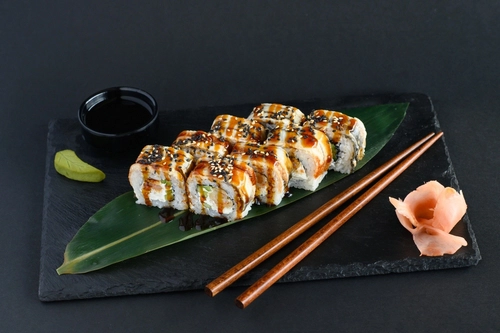Sushi is more than just raw fish and rice—it’s a delicately crafted culinary experience that reflects centuries of Japanese tradition and a harmonious balance of flavor, texture and presentation. Central to this experience are the condiments and garnishes that accompany each sushi plate. Among these, the most iconic is the pink-hued pickled ginger that piques curiosity among diners: What is that pink stuff served with sushi? Why is it there, and how does it elevate the meal?
Let’s explore the essential role of condiments like pickled ginger, wasabi and soy sauce in sushi dining, and discover how they transform a simple dish into an art form.
Introduction to Sushi and Its Condiments
The pink stuff that comes with sushi is pickled ginger, also known as gari. This slightly sweet, tangy garnish is more than a colorful addition—it’s a vital player in the sushi experience. In sushi dining, condiments are not simply accessories; they are flavor enhancers, palate cleansers and cultural expressions all rolled into one.
Condiments like wasabi and soy sauce provide spice, salt and umami that complement the delicate flavors of fresh fish and seasoned rice. Sushi ginger acts as a palate cleanser between bites, allowing diners to fully appreciate each unique sushi piece. These accompaniments are deeply rooted in Japanese culinary tradition and reflect the emphasis on harmony and refinement in Japanese cuisine.
Sushi garnishes are also visually and aromatically inviting. Whether it’s the green punch of wasabi or the soft pink of gari, these elements are thoughtfully placed to enhance the overall dining experience.
The Significance of Pickled Ginger in Sushi
Pickled ginger is thinly sliced young ginger root marinated in a mixture of vinegar and sugar. Its distinct pink hue often results from the use of young ginger, which naturally turns pink when pickled. Young ginger is milder, juicier and more tender than mature ginger, which has a tougher texture and a stronger, spicier flavor.
The primary role of pink ginger in sushi is to cleanse the palate between different types of sushi. Each piece of sushi has a unique flavor profile, and eating gari between bites helps reset your taste buds so you can fully enjoy the next piece without lingering flavors from the previous one.
Sakura denbu is sometimes mistaken for pickled ginger, especially by those unfamiliar with Japanese cuisine. Both are pink and often served with sushi or in bento boxes, but they differ significantly in texture, taste and purpose. While pickled ginger is thinly sliced, tangy and used to cleanse the palate, Sakura denbu is fluffy, sweet and used as a colorful topping or garnish.
Beyond taste, pickled ginger offers digestive benefits. Ginger is known for its anti-inflammatory and anti-nausea properties. It can stimulate digestion and ease discomfort, making it a healthful complement to raw fish dishes. In Japanese dining, this thoughtful approach to how food interacts with the body is deeply ingrained.
Exploring Sushi Condiments: Beyond Pickled Ginger
While gari plays a critical role, other sushi condiments are equally important. Wasabi, a green paste made from the rhizome of the wasabia japonica plant, provides a spicy kick. Its heat is sharp but short-lived, unlike chili peppers, and it helps kill bacteria that may be present in raw fish. Authentic wasabi is rare and expensive; most restaurants serve a mixture of horseradish, mustard and green coloring as a substitute.
Soy sauce adds saltiness and umami, intensifying the flavor of both fish and rice. However, using soy sauce requires finesse. Dip only the fish side—never the rice—as rice can soak up too much sauce, overpowering the flavor balance.
There’s a particular etiquette to using condiments in sushi dining. Avoid mixing wasabi into soy sauce unless the chef hasn’t already seasoned the sushi. Trust in the chef’s craftsmanship is an essential part of the experience, especially in traditional settings.
Sushi Ingredients: The Foundation of Flavor
Understanding sushi condiments also involves knowing the building blocks of sushi itself. At its core, sushi includes vinegared rice, fresh fish and select vegetables or seaweed.
Sushi rice, or shari, is seasoned with a blend of rice vinegar, sugar and salt. This mixture, known as sushi seasoning, balances sweet, sour and salty elements, providing a subtle yet crucial backdrop for the fish.
To prepare sushi rice, start with short-grain rice, rinse it until the water runs clear, and cook it to a sticky consistency. Once cooled slightly, gently fold in the sushi vinegar mix. This step is essential for flavor and texture, as overly aggressive mixing can break the grains.
Additional ingredients—such as nori (seaweed), cucumber, avocado and sesame seeds—introduce texture and variety, laying the foundation for countless sushi variations.
Sushi Variations and Types
Sushi is not a one-size-fits-all dish. From the minimalist elegance of nigiri (a slice of fish over vinegared rice) to the layered complexity of maki (rolls wrapped in seaweed), each type offers a distinct experience.
Sashimi, which omits rice entirely, highlights the fish’s flavor and texture, while temaki (hand rolls) and chirashi (scattered sushi bowls) offer more casual alternatives. Regional variations across Japan also influence sushi styles. In Osaka, oshi-zushi is pressed into a box mold, while in Tokyo, edomae sushi emphasizes freshness and precision.
In the U.S. and other countries, modern innovations like tempura rolls, spicy mayo, and even sushi burritos show how global palates influence the tradition. However, whether traditional or trendy, condiments like pickled ginger and wasabi remain integral in all variations.
The Art and Culture Behind Every Bite of Sushi
To fully appreciate sushi, one must embrace the artistry that defines it. Each piece is crafted with attention to flavor balance, visual harmony and tradition. Condiments like gari play an essential role in this art by enhancing, rather than masking, the natural flavors of each component.
Sushi’s history dates to Southeast Asia, where fermented rice was used to preserve fish. Over time, it evolved in Japan into the fresh, delicate cuisine we know today. With its global rise, sushi remains a symbol of refinement, discipline and creativity.
Understanding the proper use of condiments not only improves the taste experience but also deepens respect for the culinary heritage behind each bite. Whether you’re enjoying a classic nigiri or a contemporary fusion roll, take a moment to savor the subtle magic of gari and its companions.
Sushi is a rich interplay of flavor, culture and ritual. The next time you’re served that curious pink garnish alongside your sushi, remember: it’s more than a side—it’s a key player in a centuries-old culinary story. From pickled ginger to wasabi and soy sauce, every condiment has a role to play in transforming sushi into the artful, immersive experience it’s meant to be.


Recent Comments